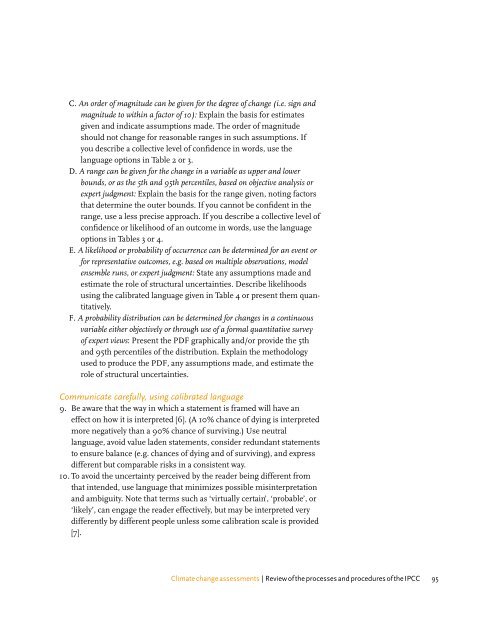Climate change assessments Review of the processes and ...
Climate change assessments Review of the processes and ...
Climate change assessments Review of the processes and ...
Create successful ePaper yourself
Turn your PDF publications into a flip-book with our unique Google optimized e-Paper software.
C. An order <strong>of</strong> magnitude can be given for <strong>the</strong> degree <strong>of</strong> <strong>change</strong> (i.e. sign <strong>and</strong><br />
magnitude to within a factor <strong>of</strong> 10): Explain <strong>the</strong> basis for estimates<br />
given <strong>and</strong> indicate assumptions made. The order <strong>of</strong> magnitude<br />
should not <strong>change</strong> for reasonable ranges in such assumptions. If<br />
you describe a collective level <strong>of</strong> confidence in words, use <strong>the</strong><br />
language options in Table 2 or 3.<br />
D. A range can be given for <strong>the</strong> <strong>change</strong> in a variable as upper <strong>and</strong> lower<br />
bounds, or as <strong>the</strong> 5th <strong>and</strong> 95th percentiles, based on objective analysis or<br />
expert judgment: Explain <strong>the</strong> basis for <strong>the</strong> range given, noting factors<br />
that determine <strong>the</strong> outer bounds. If you cannot be confident in <strong>the</strong><br />
range, use a less precise approach. If you describe a collective level <strong>of</strong><br />
confidence or likelihood <strong>of</strong> an outcome in words, use <strong>the</strong> language<br />
options in Tables 3 or 4.<br />
E. A likelihood or probability <strong>of</strong> occurrence can be determined for an event or<br />
for representative outcomes, e.g. based on multiple observations, model<br />
ensemble runs, or expert judgment: State any assumptions made <strong>and</strong><br />
estimate <strong>the</strong> role <strong>of</strong> structural uncertainties. Describe likelihoods<br />
using <strong>the</strong> calibrated language given in Table 4 or present <strong>the</strong>m quantitatively.<br />
F. A probability distribution can be determined for <strong>change</strong>s in a continuous<br />
variable ei<strong>the</strong>r objectively or through use <strong>of</strong> a formal quantitative survey<br />
<strong>of</strong> expert views: Present <strong>the</strong> PDF graphically <strong>and</strong>/or provide <strong>the</strong> 5th<br />
<strong>and</strong> 95th percentiles <strong>of</strong> <strong>the</strong> distribution. Explain <strong>the</strong> methodology<br />
used to produce <strong>the</strong> PDF, any assumptions made, <strong>and</strong> estimate <strong>the</strong><br />
role <strong>of</strong> structural uncertainties.<br />
Communicate carefully, using calibrated language<br />
9. Be aware that <strong>the</strong> way in which a statement is framed will have an<br />
effect on how it is interpreted [6]. (A 10% chance <strong>of</strong> dying is interpreted<br />
more negatively than a 90% chance <strong>of</strong> surviving.) Use neutral<br />
language, avoid value laden statements, consider redundant statements<br />
to ensure balance (e.g. chances <strong>of</strong> dying <strong>and</strong> <strong>of</strong> surviving), <strong>and</strong> express<br />
different but comparable risks in a consistent way.<br />
10. To avoid <strong>the</strong> uncertainty perceived by <strong>the</strong> reader being different from<br />
that intended, use language that minimizes possible misinterpretation<br />
<strong>and</strong> ambiguity. Note that terms such as ‘virtually certain’, ‘probable’, or<br />
‘likely’, can engage <strong>the</strong> reader effectively, but may be interpreted very<br />
differently by different people unless some calibration scale is provided<br />
[7].<br />
<strong>Climate</strong> <strong>change</strong> <strong>assessments</strong> | <strong>Review</strong> <strong>of</strong> <strong>the</strong> <strong>processes</strong> <strong>and</strong> procedures <strong>of</strong> <strong>the</strong> IPCC 95

















